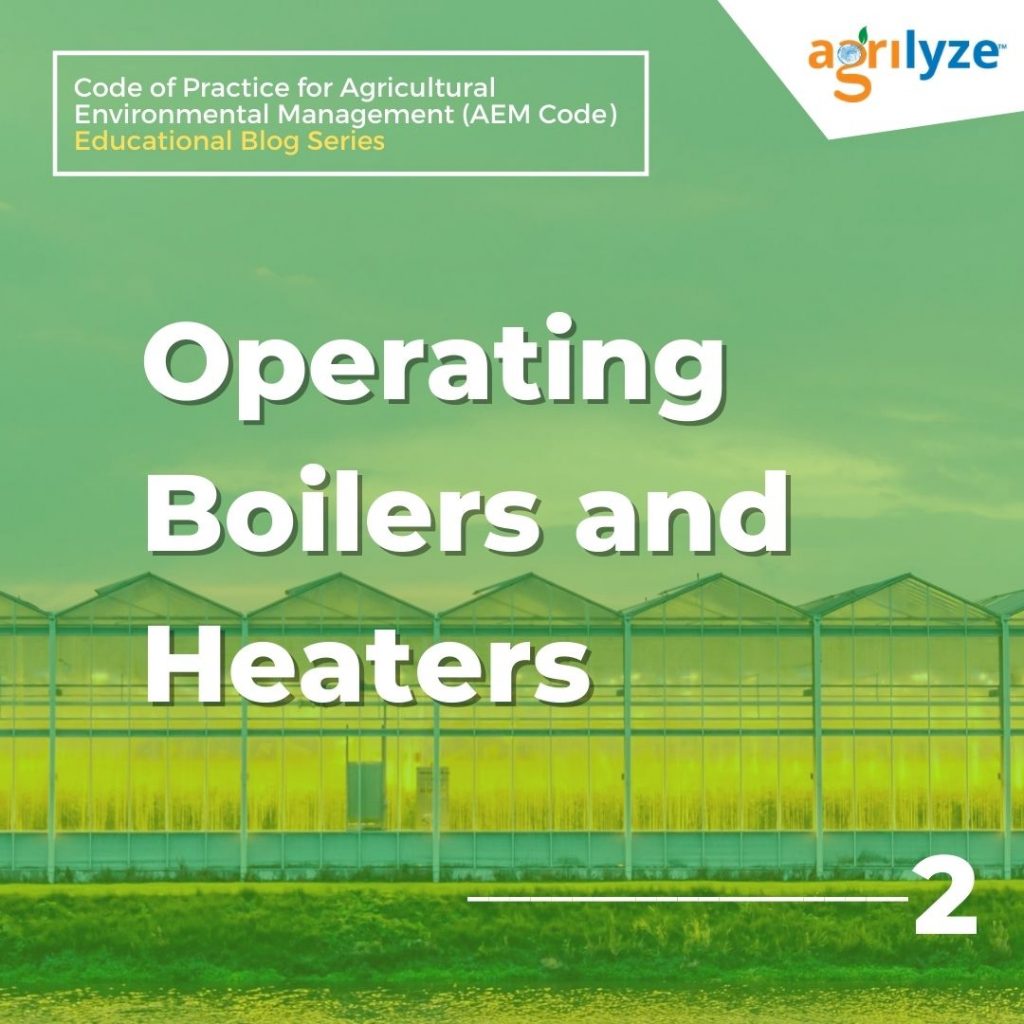Code of Practice for Agricultural Environmental Management – Agricultural Boilers & Heaters
If you are using these systems in a greenhouse or tree seedling nursery, bear in mind that units with a higher than 0.15 MW capacity must be registered under the Code of Practice for Agricultural Environmental Management. If the capacity is less than that, it does not need to be registered; however, it must still meet a design standard, as stated in the AEM Code.
Opacity Tests
Based on the AEM Code, all boilers and heaters must be tested visually for opacity 60 minutes after the boiler or heater is started and before shutdown procedures begin.
Particulate Matter Tests
If your boiler or heater has an output greater than 1.0 MW or increased capacity by 25%, it must be tested. To determine boiler output capacity, check the nameplate or request this information from the boiler manufacturer.
Click here for more information on agricultural boilers and heaters.
Pain Points
Farmers are looking for ways to ensure that their boilers and heaters are operating with lower environmental impacts and better temperature control. Some other benefits they are looking for are safety and durability.
Taking greenhouses as an example, growers would like to produce healthy, high-quality plants in a consistent environment. Greenhouse heating allows growers to control their growing environment.
Boilers and heaters deliver heat directly to plants and can provide the following advantages:
- Controlled growing environment
- Extended growing season
- Increased yields
- Accelerated rooting and plant growth
- Reduced disease and improved plant quality
- Up to 40% fuel efficiency savings over conventional forced-air heating
- Flexibility to heat by zone, plus soil and plant temperature control
Based on the type of greenhouse or crop, the equipment being used, and even the geographical location, farmers should perform a precise and complete analysis of the heating equipment requirements to better protect the environment.
The adverse effects of combustion on the environment – particularly greenhouse gas (GHG) emissions released to the atmosphere contributing to global warming – have received much attention in recent years.
Climate change resulting from global warming is one of the most significant challenges facing Canada and the world. Managing combustion processes and improving energy generation efficiency and use are two of the critical strategies for reducing atmospheric emissions. By ensuring you are following the Code of Practice for Agricultural Environmental Management, you can design your heating system to achieve optimal performance for your crop’s growth while also optimizing your energy consumption and protecting the environment.
How Agrilyze Can Help
- Monitoring sensors and tracking data over time – track temperature in greenhouses to optimize heating or monitor output from the equipment itself to ensure it is running efficiently. By monitoring temperature and humidity fluctuations online, you can detect problems early, and in real-time mode.
- Notifications when sensors go out of range – receive a notification if the temperature drops too low. A wireless temperature alarm is indispensable if you want to keep a healthy greenhouse—track problems such as power outages, temperature fluctuations, water damage, and intrusion.
- Aggregate and correlate data – pull in data from different sources (weather, indoor temperature, historical usage). Agrilyze provides farmers with an understanding of what to expect and how to build budgets for equipment and use.
- Data management and tracking – put all the data in a system, track, analyze and audit it. For example, obtain gas usage for September, October and November in previous years and the overall costs of acquiring that gas.
It is important to note that technology is not the only contributing factor impacting energy efficiency and performance optimization. Human beings contribute as well, if not more so. From a humanistic perspective, our habits, behaviours, attitudes and most crucially actions can be critical to making strides in protecting investments and the environment.
Like a feedback loop (for more on feedback loops, check out this article), technology can be interpreted as the interaction between humans and systems. The application of technologies (or systems like the Code of Practice for Agricultural Environmental Management) can amplify your farming output, resulting in growth on many levels, not just your agricultural operation, but your personal development as a farmer, grower, or rancher.
When we input positivity (better habits, behaviours, attitudes, actions), we can increase our knowledge and understanding. This allows us to better leverage and analyze all of the information around us, which can produce local benefits to our business and the environment.
Through the tools and technologies that Agrilyze offers, you can build new skill sets and the technical competence to make smarter decisions that will help you manage your operation more effectively.
Going back to our feedback loop, it works like this:
A produces more of B which in turn produces more of A
Input Positivity produces more Results which in turn produces more Input Positivity
If you would like to see more about this in a blog post, let us know!
By applying this mentality combined with the need to conserve energy, we should continuously aim to:
- Understand patterns in energy usage, then use the appropriate tools to measure and analyze the patterns
- Make better choices about the equipment we choose to use so that we can meet standards to meet regulations such as the AEM Code
- Decide on the most appropriate energy source or provider to better manage and decrease costs
- Consider if your operation has specific requirements around heating that need to be addressed now or in the future
If you have feedback about this post or would like us to explore a particular topic, please let us know by sending an email to [email protected].
Click here to learn more about Agrilyze and Greenhouses.
Read the Code of Practice for Agricultural Environmental Management – Introduction (with infographic).



